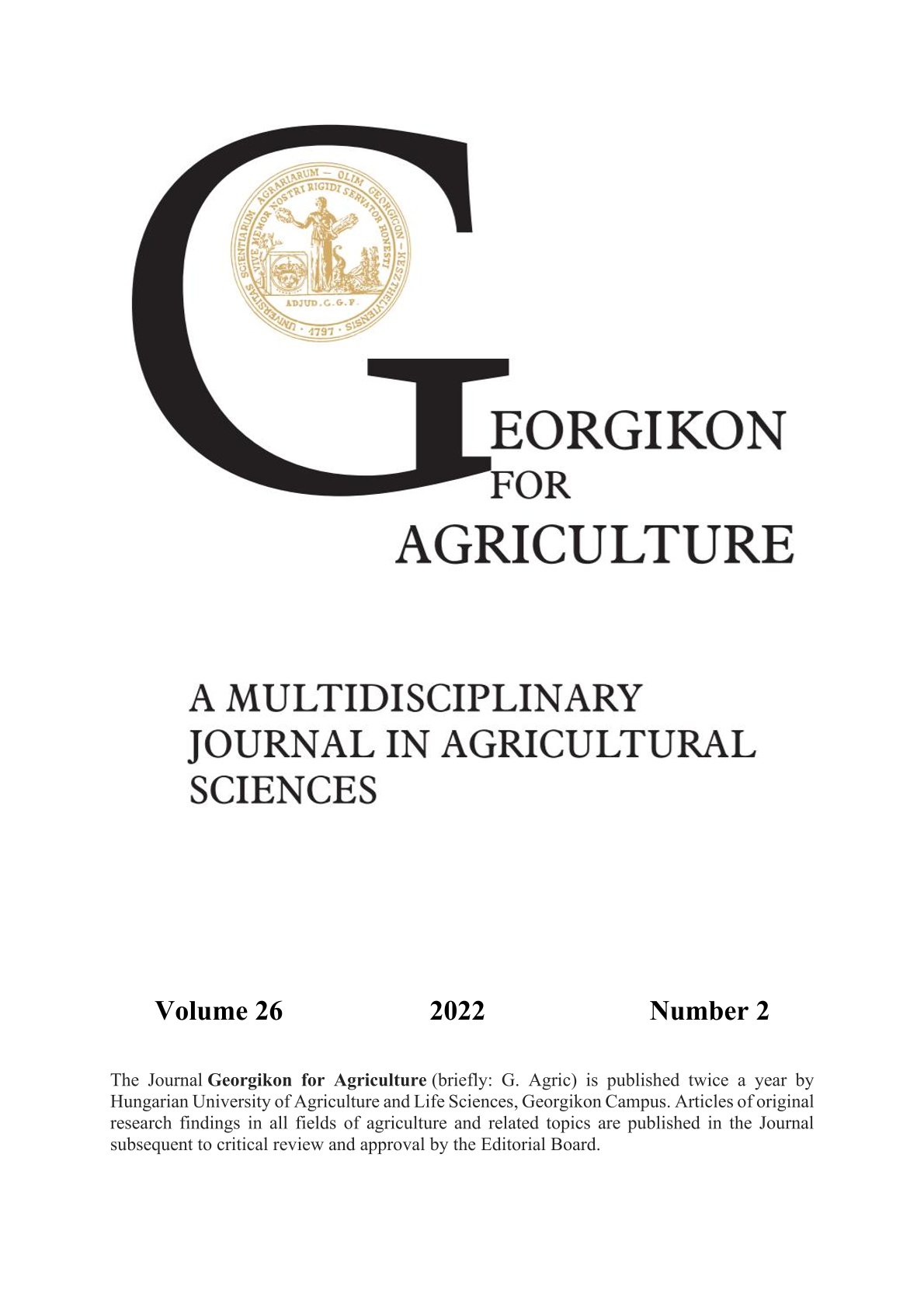Detection of viral infections in a hungarian vineyard
Kulcsszavak:
DAS-ELISA, szőlő, vírus, növényvédelemAbsztrakt
A Vitaceae családba tartozó szőlő (Vitis vinifera) a világ egyik legfontosabb gazdasági gyümölcsnövénye. Magyarországon több ezer éve termesztenek szőlőt a Kárpát -medencében, ahol az éghajlati és talajviszonyok kedvezőek a szőlő termesztéséhez. A vírusfertőzések negatívan befolyásolták a fajták produktivitását és az állományok idő előtti leromlását és pusztulását okozzák. A Közép-dunántúli régió Lesencefalu szőlőültetvényein végeztünk vizsgálatokat, amelynek a célja a szőlőt fertőző fontos vírusos betegségek azonosítása, és a védekezési stratégia javítása volt. Az othello hazánkban is gyakori termesztésű fajta, feltételezve, hogy tolerálja a fontos szőlőbetegségeket. 60 mintát gyűjtöttünk Othello szőlőfajtából, és laboratóriumban DAS-ELISA segítségével azonosítottuk a kórokozókat. A vizsgálatok során hat vírus (GLRaV1, GLRaV2, GLRaV3, GLRaV6, GLRaV7 és GFkV) jelenlétét azonosítottuk. A 60 Othello szőlőminta közül 27 volt fertőzött. A legnagyobb arányban a GLRaV1 jelenlétét igazoltuk, ezzel szemben a GLRaV3 előfordulása volt a legalacsonyabb. Összesen 13 minta esetében mutattunk ki komplex vírusfertőzést.
Hivatkozások
Adnan, M.R., Chen, Z., Yuan, X., Kisi, O., El-Shafie, A., Kuriqi, A. and Ikram, M. 2020. Reference Evapotranspiration Modeling Using New Heuristic Methods. Entropy. 22(5). 547. https://doi.org/10.3390/e22050547
Al Rwahnih, M., Daubert, S., Golino, D. and Rowhani, A. 2009. Deep sequencing analysis of RNAs from a grapevine showing Syrah decline symptoms reveals a multiple virus infection that includes a novel virus. Virology. 387. 395–401. https://doi.org/10.1016/j.virol.2009.02.028
Alabi, O.J., Casassa, L.F., Gutha, L.R., Larsen, R.C., Henick-Kling, T., Harbertson, J.F. and Naidu, R.A. 2016. Impacts of grapevine leafroll disease on fruit yield and grape and wine chemistry in a wine grape (Vitis vinifera L.) cultivar. PLoS ONE. 11. e0149666. https://doi.org/10.1371/journal.pone.0149666
Buyukbay, E., Uzunoz, M. and Sibel, G. 2011. Post-harvest losses in tomato and fresh bean production in Turkey. Scientific Research and Essays. 6(7). 1656–1666. https://doi.org/10.5897/SRE11.186
Clark, M.F., Adams, A.N. and Barbara, D.J. (1976). The Detection of Plant viruses by Enzyme-Linked Immunosorbent Assay (ELISA). Acta Hortic. 67, 43–50. https://doi.org/10.17660/ActaHortic.1976.67.2
Credi, R. 2001. Malattie infettive latenti e semilatenti della vite [Latent and semi latent infectious diseases of grapevine]. Quaderno di Viticoltura ed Enologia, Università di Torino 25. 15–25. https://om.ciheam.org/om/pdf/b55/00800521.pdf
FAO, 2012. Major Fruits and Vegetables producing Countries in the World (2010-2011). Rome, Italy.
Frison, E. A. and Ikin, R. (eds.). 1991. FAO/IBPGR Technical Guidelines for the Safe Movement of Grapevine Germplasm. Food and Agriculture Organization of the United Nations, Rome/International Board for Plant Genetic Resources, Rome.
Habili, N., Komínek, P. and Little, A. 2007. Grapevine leafroll-associated virus 1 as a common grapevine pathogen. Plant Viruses 1. 63–68.
Hajdu, E. 2018. Viticulture of Hungary. cta Agraria Debreceniensis. 150. 175–182. https://doi.org/10.34101/actaagrar/150/1713
Kritzman, A., Lampel, M., Raccah, B. and Gera, A. 2001. Distribution and Transmission of Iris yellow spot virus. Plant Disease. 85. 838–842. https://doi.org/10.1094/PDIS.2001.85.8.838.
Kumar, R. T. 2010. Post-harvest profile of grapes. Ministry of Agriculture, Department of Agriculture and Cooperation, Directorate of Marketing and Inspection, MPDC, Nagpur, India. pp 72.
Lázár, J. 2003. Sanitary aspects and results of the Hungarian grape breeding. Proceedings of the VIIIth International Conference on Grape Genetics and Breeding, ISHS Acta Horticulturae 603. 755–762. https://doi.org/10.17660/ActaHortic.2003.603.107
Maliogka, V.I., Martelli, G.P., Fuchs, M. and Katis, N.I. 2015. Control of viruses infecting grapevine. Advances in Virus Research. 91. 176–227. https://doi.org/10.1016/bs.aivir.2014.11.002
Mannini, F. and Digiaro, M. 2017. In Grapevine Viruses: Molecular Biology, Diagnostics and Management Springer: AG, Chapter 23. 453–482.
Martelli, G. P. 2014. Directory of virus and virus-like diseases of the grapevine and their agents. Journal of Plant Pathology. 96(1). 1–136. http://dx.doi.org/10.4454/JPP.V96I1SUP
Meng, B., Martelli, G.P., Golino, D.A. and Fuchs, M. 2017. Grapevine Viruses: Molecular Biology, Diagnostics and Management. Springer: Heidelberg, Germany, 31–46.
Naidu, R., Rowhani, A., Fuchs, M., Golino, D. and Martelli, G. P. 2014. Grapevine leafroll: A complex viral disease affecting a high-value fruit crop. Plant Disease. 98(9). 1172–1185. http://dx.doi.org/10.1094/ PDIS-08-13-0880-FE
OEPP/EPPO, 2008. Certification scheme: Pathogen-tested material of grapevine varieties and rootstocks. PM 4/8(2), Bulletin OEPP/EPPO Bulletin. 38. 422–429.
OIV, 2016. Global economic viticulture report. Organization Internationale, Paris.
Rowhani, A., Uyemoto, J. K., Golino, A. D. and Martelli, G. P. 2005. Pathogen testing and certification of Vitis and Prunus species. Annual Review of Phytopathology. 43: 261–278. https://doi.org/10.1146/annurev.phyto.43.040204.135919
Seguin, J., Rajeswaran, R., Malpica-Lopez, N., Martin, R.R., Kasschau, K., Dolja, V.V., Otten, P., Farinelli, L. and Poogin, M.M. 2014. De novo reconstruction of consensus master genomes of plant RNA and DNA viruses from siRNAs. PloS One. 9. e88513. https://doi.org/10.1371/journal.pone.0088513
Senthil, R., Prabakar, K., Rajendran, L. and Karthikeyan, G. 2011. Efficacy of different biological control agents against major postharvest pathogens of grapes under room temperature storage conditions. Phytopathology Mediterranea. 50. 55−65. https://doi.org/10.14601/Phytopathol_Mediterr-3115
Smithsonian. 2013. Grapes and Viticulture in Hungary: Hungarian Heritage Roots to Revival. Folklife Festival- Washngton D.C., June26-June 30 and July 3−July 7.
Walker, A. R., Lee, E., Bogs, J., McDavid, D. A. J., Thomas, M. R. and Robinson, S. P. 2007. White grapes arose through the mutation of two similar and adjacent regulatory genes. Plant J. 49. 767−959. https://doi.org/10.1111/j.1365-313X.2006.02997.x
Letöltések
Megjelent
Folyóirat szám
Rovat
License
Copyright (c) 2022 Agyemang Evans Duah, Nsongoma Martine Lihwa, Pásztor György, Takács András

This work is licensed under a Creative Commons Attribution-NonCommercial-NoDerivatives 4.0 International License.
The articel is under the Creative Commons 4.0 standard licenc: CC-BY-NC-ND-4.0. Under the following terms: You must give appropriate credit, provide a link to the license, and indicate if changes were made. You may do so in any reasonable manner, but not in any way that suggests the licensor endorses you or your use. You may not use the material for commercial purposes. If you remix, transform, or build upon the material, you may not distribute the modified material. You may not apply legal terms or technological measures that legally restrict others from doing anything the license permits.




 Georgikon for Agriculture
Georgikon for Agriculture